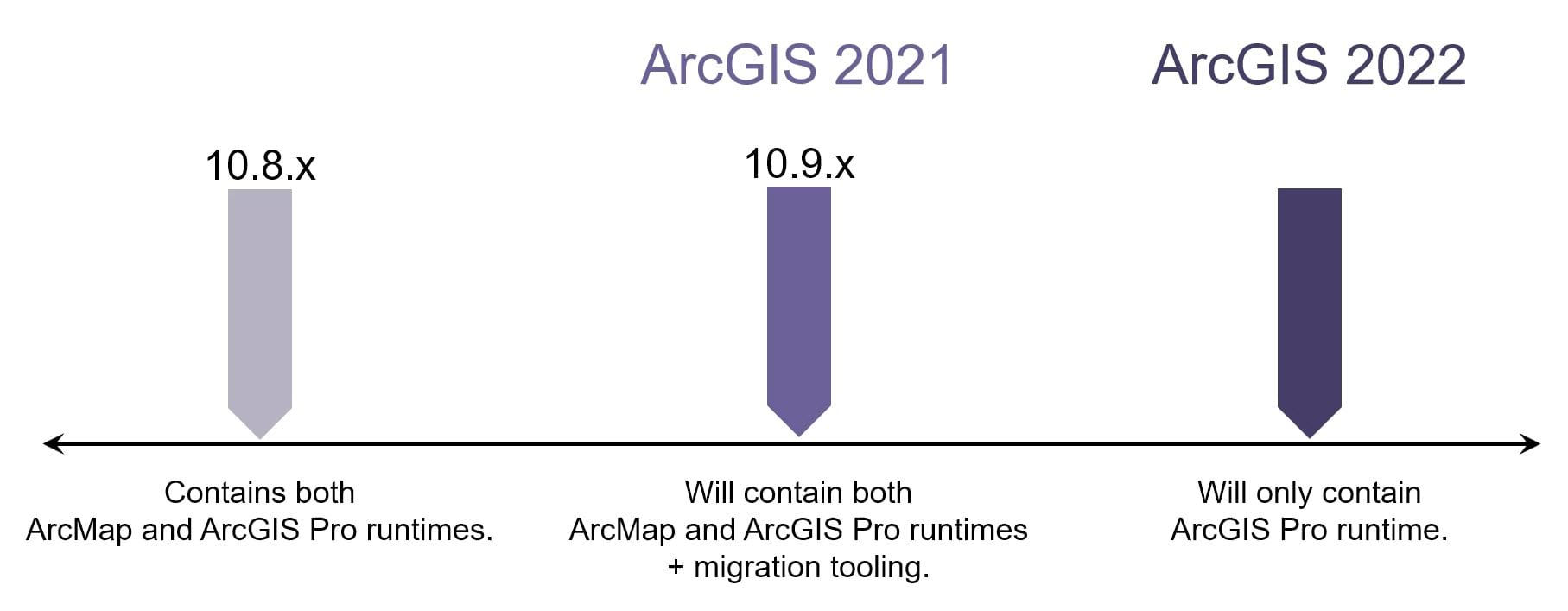With a new year comes change! And one of those changes involves publishing and consuming services from ArcMap. Specifically, ArcGIS Enterprise 10.9.x, part of the ArcGIS 2021 releases, will be the last release series that supports publishing new services from ArcMap. If you are an ArcGIS Enterprise administrator, read on to see how this might affect you and your organization.
ArcGIS Enterprise’s ArcGIS Server component currently includes two internal runtimes: one runtime for services published from ArcMap and a second runtime for services published from ArcGIS Pro. These two runtimes have been present for years, running “under the hood” – you may not have even known they were both there. And that’s okay! The reason we need to talk about this now is because the ArcMap-based runtime will be removed from the software, starting with the ArcGIS 2022 releases.
This means with releases of ArcGIS Enterprise from 2022 onwards, it will no longer be possible to publish services from ArcMap and ArcMap-based ArcPy to ArcGIS Server sites (both federated and non-federated). Additionally, certain ArcMap-based services will no longer run if present during an upgrade to an ArcGIS 2022, or later, release of ArcGIS Enterprise. Most services originally published from ArcMap will continue to run unchanged. Do note though that some will require republishing from ArcGIS Pro to continue running on future versions of ArcGIS Server.
Now you may have noticed we’re talking about things happening next year, in 2022, and we’re barely into 2021. That’s because we wanted to give you the heads up so you can start planning, well in advance, for your ArcGIS Enterprise deployments.
Why is Esri removing the ArcMap-based runtime from ArcGIS Enterprise?
With last year’s announcement regarding ArcGIS Desktop continued support, it is time to begin phasing out the ArcMap-based runtime components from ArcGIS Enterprise as well. As many ArcGIS Enterprise users are migrating their workflows to ArcGIS Pro, it is time for Esri’s efforts to be focused on the ArcGIS Pro-based runtime in ArcGIS Enterprise. This will allow for us to serve you, our users, better!
Will this change affect me?
The removal of the ArcMap-based runtime for ArcGIS Enterprise will affect you if you have ArcGIS Server services leveraging the ArcMap-based runtime. This includes workflows that publish from ArcMap and/or consume services that were originally published from ArcMap.
It is important to understand that even if you have already successfully transitioned all new publishing to use ArcGIS Pro, you may still have old services running that were originally published from ArcMap. Any such services will need to be identified to ensure that they can be migrated to the ArcGIS Pro-based runtime.
When do I need to migrate my services to use the ArcGIS Pro-based runtime?
You can start migrating your services to the ArcGIS Pro-based runtime right away but you may want to wait – ArcGIS Enterprise 10.9.x, part of the ArcGIS 2021 releases, will include an UpdateArcMapServices tool to help you out. This tool will quickly and easily switch compatible services from the ArcMap-based runtime to the ArcGIS Pro-based runtime. For services that are not compatible, such as map services with a server object extension (SOE) or server object interceptor (SOI), and geoprocessing services, these services will need to be manually migrated from the ArcMap-based runtime to the ArcGIS Pro-based runtime. Stay tuned for the details of migration workflows with the upcoming releases.
ArcGIS Enterprise 10.9.x will be the only set of releases to include these tooling and migration paths, as it is the last opportunity to have ArcMap and ArcGIS Pro-based services run side by side.
The ArcGIS 2022 releases of ArcGIS Enterprise will only contain the ArcGIS Pro-based runtime. If you’re using ArcGIS Server services built off the ArcMap-based runtime, they will need to be migrated or republished before you upgrade to an ArcGIS 2022 release or any subsequent release.

What does Esri recommend?
Because ArcGIS Enterprise 10.9.x, part of the ArcGIS 2021 releases, will be the last set of releases to include both the ArcMap and ArcGIS Pro-based runtimes, consider upgrading to an ArcGIS 2021 release once available. In addition to being the last set of releases to include both the ArcMap and ArcGIS Pro-based runtimes, the ArcGIS 2021 releases will include the migration tooling. This will allow for you to make sure all services are migrated to the latest runtime before ultimately upgrading to an ArcGIS 2022 release, or later, that contains only the ArcGIS Pro-based runtime.
What if I can’t migrate my ArcGIS Server services to use the ArcGIS Pro-based runtime?
If you are unable to migrate your ArcGIS Server services to use the ArcGIS Pro-based runtime, you should keep ArcGIS Enterprise at a version that contains both the ArcMap and ArcGIS Pro-based runtimes until they are ready to fully move to ArcGIS Pro-based services. This means remaining on ArcGIS Enterprise 10.9.x, or earlier. ArcGIS Enterprise 10.9.1 will follow the long-term support product life cycle, ensuring support into 2027.
If this is your situation, keep in mind that it is possible to use older ArcGIS Server sites with a newer ArcGIS Enterprise deployment. It will, as an example, be possible to federate ArcGIS Server 10.9.1 to a later ArcGIS Enterprise deployment. This provides an option for keeping some services on an older release while continuing to be able to upgrade the base ArcGIS Enterprise deployment.
We hope to make this transition as smooth as possible for you. As we said, we wanted to share this information with you to make sure you’re aware, but more details will be coming with the upcoming ArcGIS 2021 releases later this year so stay tuned!

Commenting is not enabled for this article.